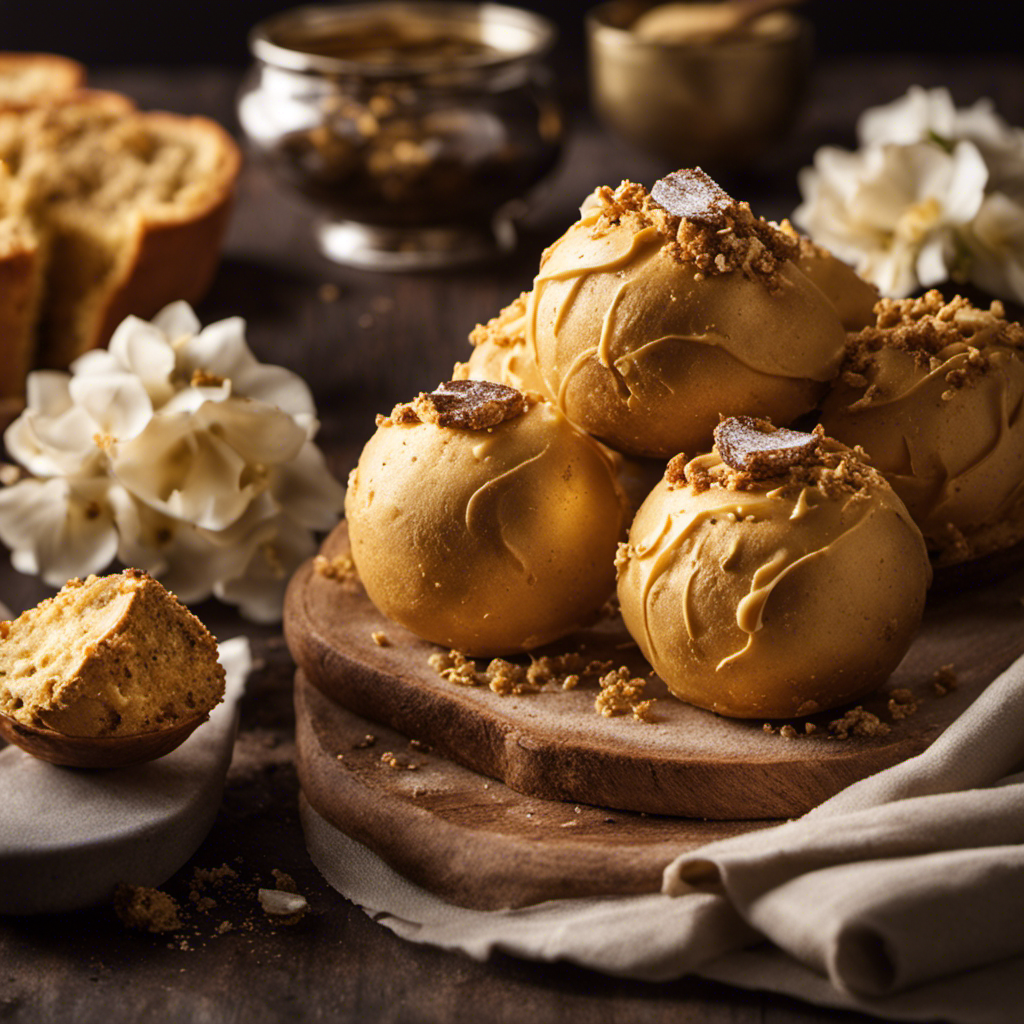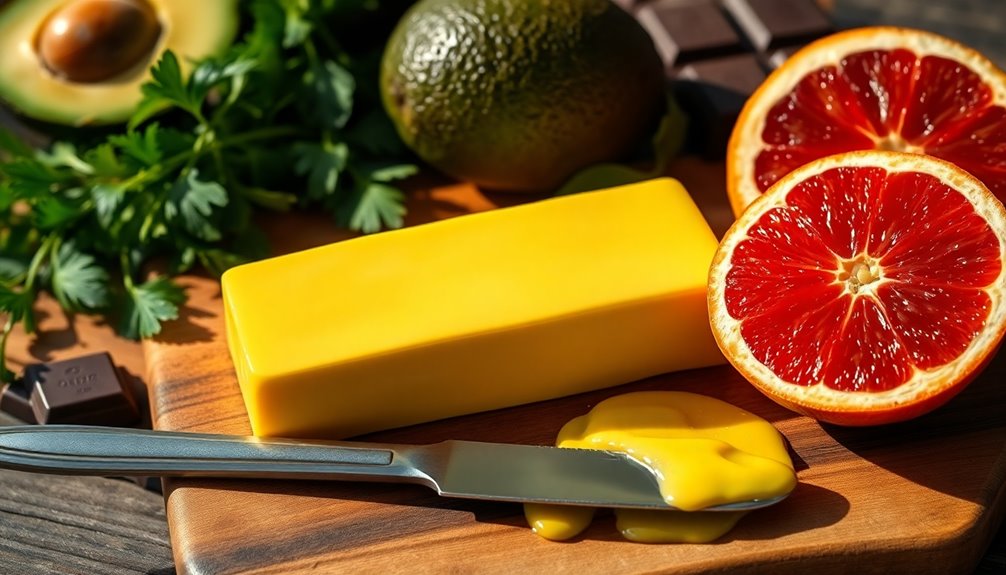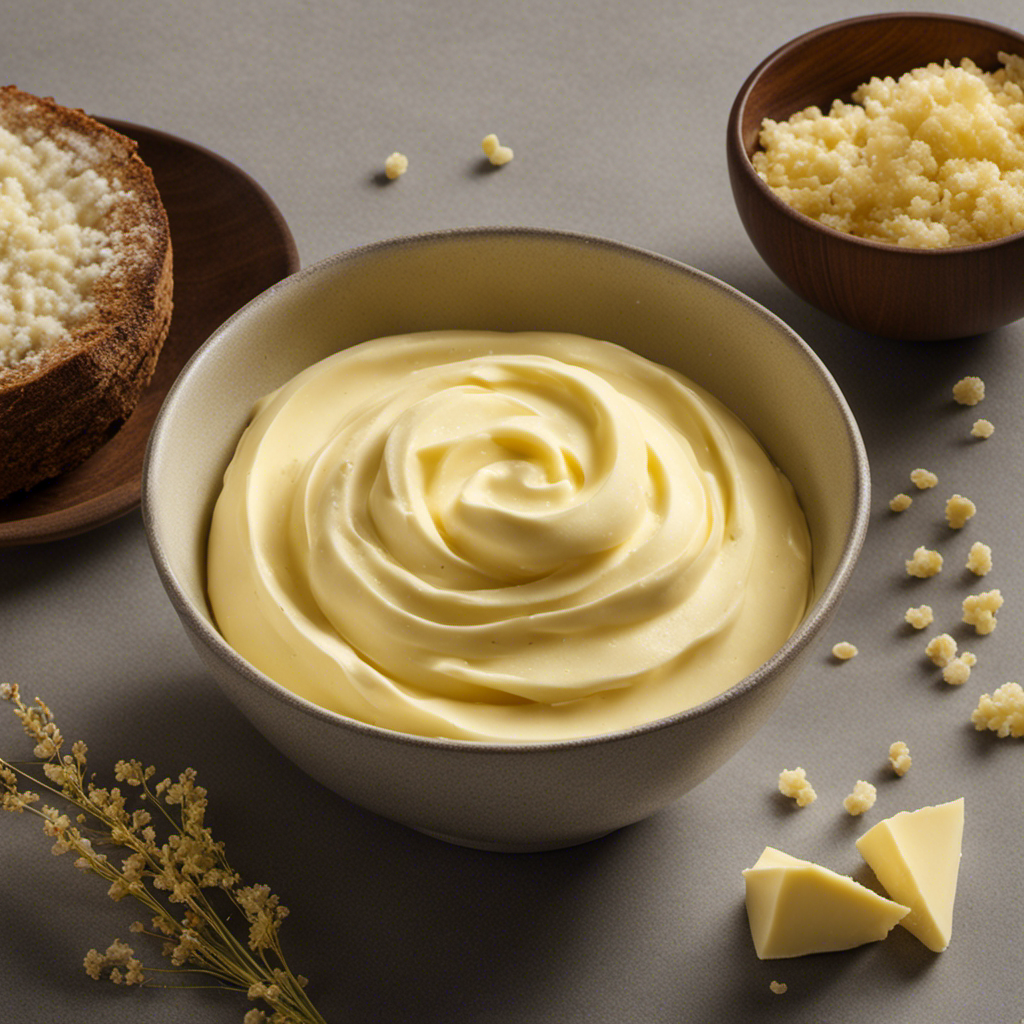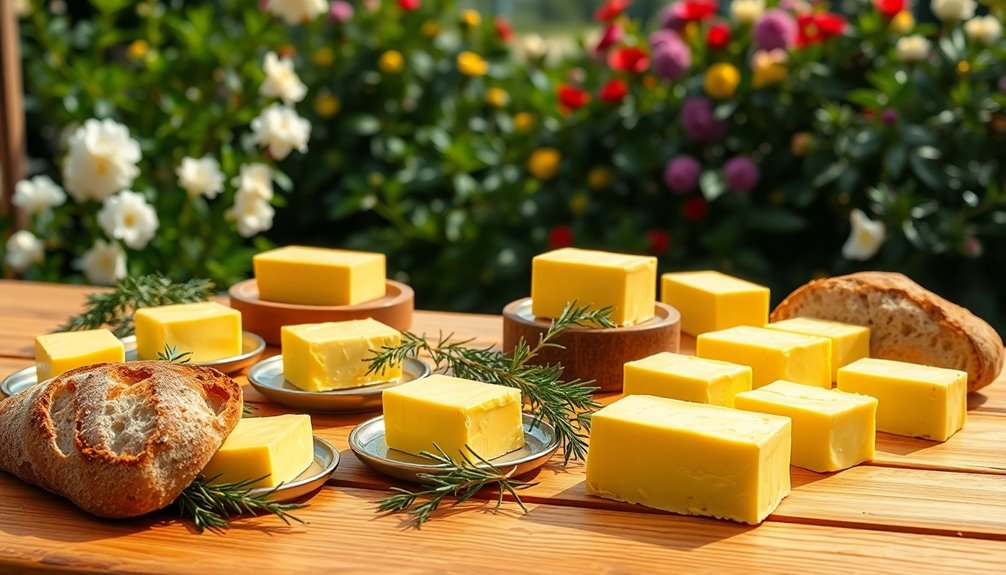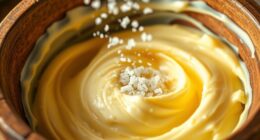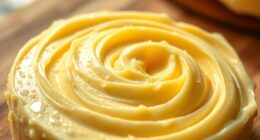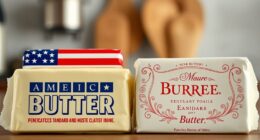As a baker, I firmly believe that butter is the key element in creating delicious baked goods. It’s the magical ingredient that unlocks a world of flavor and texture.
But with so many options to choose from, it can be overwhelming to find the best butter for baking. In this article, we’ll explore the different types of butter, compare salted and unsalted options, delve into the benefits of European style butter, and even discuss the butterfat content.
So, let’s dive in and discover the butter that will take your baking to the next level.
Key Takeaways
- Churned butter provides a rich, creamy flavor and is great for spreading on toast or using in recipes that call for a buttery taste.
- Cultured butter adds a tangy, slightly sour taste and is often used in baking to add complexity to pastries and breads.
- Unsalted butter provides a neutral taste and allows for more control over the saltiness of recipes.
- European style butter has a richer flavor profile and a higher fat content, resulting in a tender and moist texture.
Understanding the Different Types of Butter
If you’re unsure about the different types of butter, you can easily become informed by doing some research.
When it comes to baking, two popular types of butter are churned and cultured butter. Churned butter is made by agitating cream until it separates into butter and buttermilk. It has a rich, creamy flavor and is great for spreading on toast or using in recipes that call for a buttery taste.
On the other hand, cultured butter is made by adding live bacteria cultures to cream before churning. It has a tangy, slightly sour taste and is often used in baking to add complexity to pastries and breads.
When determining the best butter for flaky pie crusts, it is important to consider the flavor profile you want to achieve. Churned butter will give you a classic, buttery taste, while cultured butter will add a unique, tangy twist.
Now, let’s move on to comparing salted and unsalted butter for baking.
Comparing Salted and Unsalted Butter for Baking
When it comes to choosing between salted and unsalted butter for baking, there are a few key factors to consider.
Firstly, the taste can vary significantly between the two types, with salted butter offering a savory, slightly salty flavor, while unsalted butter provides a neutral taste.
Secondly, the choice of butter can impact the overall outcome of your recipe, as the salt content in salted butter can affect the balance of flavors in your baked goods.
Lastly, it’s important to consider the storage and shelf-life of each type, as unsalted butter tends to have a shorter shelf-life and can spoil more quickly than salted butter.
Salted Vs Unsalted Taste
The salted butter adds a subtle savory note to the baked goods. It enhances the overall flavor and can be a preferred choice for those who enjoy a hint of saltiness in their desserts. However, when it comes to baking, the salted vs unsalted butter debate is a matter of personal preference.
Here are some key points to consider regarding the taste impact of salted vs unsalted butter:
-
Salted butter:
-
The salt content in salted butter can vary between brands, so it’s important to read the label.
-
It can provide a balance of flavors, especially in recipes that call for a small amount of salt.
-
The salt can enhance the sweetness of certain baked goods, like cookies or caramel desserts.
-
Unsalted butter:
-
It allows for more control over the saltiness of your baked goods, as you can add salt according to your taste.
-
It provides a neutral base and allows other ingredients, such as vanilla or spices, to shine.
-
It is a versatile option that can be used in both sweet and savory recipes.
Impact on Recipe
To achieve the desired taste in your recipe, consider using unsalted butter and adding salt according to your preference. The type of butter you use can have a significant impact on the texture and overall result of your baked goods.
Unsalted butter gives you more control over the saltiness of your recipe, allowing you to adjust it to your liking. Additionally, unsalted butter tends to have a higher fat content, which can lead to a more tender and delicate texture in your baked goods.
On the other hand, salted butter can have an effect on browning due to its higher salt content. It can result in a more golden and caramelized appearance. So, when choosing butter for your baking, consider how it will impact the texture and browning of your final product.
Now let’s move on to the next section and discuss the storage and shelf-life of butter.
Storage and Shelf-Life?
Storing butter in the refrigerator can help extend its shelf-life. When considering the shelf life of butter, there are a few key factors to keep in mind.
Proper butter storage techniques include:
- Keeping butter away from strong odors, as it can easily absorb them and affect its taste.
- Using an airtight container or wrapping it tightly in foil or plastic wrap to prevent exposure to air and moisture.
- Storing butter in the coldest part of the refrigerator, preferably in the dairy compartment.
Shelf life considerations for butter include:
- The quality and freshness of the butter at the time of purchase.
- The storage conditions and temperature fluctuations it experiences.
- The presence of preservatives, which can help extend the shelf life.
Exploring the Benefits of European Style Butter
When it comes to baking, I’ve found that using European style butter can make a noticeable difference in the flavor of my baked goods.
European style butter has a richer flavor profile compared to regular butter, which adds a depth of taste to my recipes.
Additionally, European style butter has a higher fat content, which contributes to a tender and moist texture in my baked goods.
Richer Flavor Profile
You’ll love the richer flavor profile that certain brands of butter can bring to your baked goods. When it comes to achieving that perfect taste and texture in your cakes, cookies, and pastries, the butter you choose plays a crucial role.
Here are three key factors to consider when looking for a butter with a richer flavor profile:
-
Butterfat content: Higher butterfat content results in a creamier and more flavorful butter. Look for brands that have a higher percentage of butterfat, such as European-style butters, which often contain 82% butterfat compared to the standard 80% in American butter.
-
Churning method: Some artisanal butter brands use traditional churning methods, which can enhance the flavor by creating a more complex and pronounced taste.
-
Source of milk: Butter made from the milk of grass-fed cows tends to have a richer and more distinct flavor compared to butter made from conventionally raised cows.
Higher Fat Content
Higher fat content in certain brands of butter can contribute to a richer flavor profile in your baked goods. When it comes to baking, using butter with a higher fat content is crucial for achieving the best results.
The fat in butter not only adds flavor but also improves the texture and tenderness of your baked treats. Quality butter with a higher fat content, usually indicated by a higher percentage of butterfat, will provide a luxurious and indulgent taste to your recipes.
It is important to choose butter made from high-quality ingredients and produced using traditional methods. These butters often have a higher fat content, resulting in a superior flavor and texture in your baked goods.
Is Organic Butter Worth the Extra Cost
Is organic butter really worth the extra cost for baking? As a baker, I understand the importance of using high-quality ingredients. When it comes to butter, there are a few key factors to consider:
-
Nutritional differences: Organic butter is made from cows that have been raised on organic feed. This means that it contains higher levels of omega-3 fatty acids and vitamin E compared to conventional butter. Organic butter also has lower levels of synthetic hormones and antibiotics, which can be beneficial for those concerned about their health.
-
Environmental impact: Organic farming practices prioritize sustainability and minimize the use of chemicals. By choosing organic butter, you are supporting a more eco-friendly approach to agriculture. Organic dairy farms also focus on animal welfare, allowing cows to graze freely and reducing their stress levels.
Considering the nutritional benefits and positive impact on the environment, organic butter is definitely worth the extra cost for baking.
Clarified Butter Vs. Regular Butter: Which Is Better for Baking
Now that we’ve discussed the cost and benefits of organic butter, let’s dive into the debate between clarified butter and regular butter for baking. Clarified butter, also known as ghee, is butter that has been melted to remove the milk solids and water content. This process gives it a higher smoke point, making it ideal for baking at high temperatures. Additionally, clarified butter has a longer shelf life and a rich, nutty flavor.
However, if you’re looking for alternatives to clarified butter, there are a few options to consider. Coconut oil, avocado oil, and olive oil can all be used as substitutes in baking recipes. Each of these alternatives has its own unique flavor profile and health benefits.
To give you a clearer understanding, here’s a table comparing the different types of butter and their benefits:
| Butter Type | Smoke Point | Shelf Life | Flavor Profile | Health Benefits |
|---|---|---|---|---|
| Clarified Butter | 450°F | Several months | Nutty | High in healthy fats, rich in vitamins A, D, and E |
| Coconut Oil | 350°F | 2 years | Mild, sweet | Boosts metabolism, supports heart health |
| Avocado Oil | 520°F | 1 year | Buttery, nutty | High in monounsaturated fats, promotes healthy skin |
| Olive Oil | 375°F | 2 years | Fruity, grassy | Rich in antioxidants, supports heart health |
The Role of Butterfat Content in Baking
If you want to achieve a tender and moist texture in your baked goods, opting for a butter with a higher butterfat content can help. Butterfat, also known as milkfat, plays a crucial role in determining the texture and moisture content of baked goods. Here’s how it impacts your creations:
- Increased butterfat content leads to a softer and more delicate texture in baked goods.
- Butter with higher butterfat content creates a moister crumb, making your cakes and cookies more enjoyable to eat.
- The higher the butterfat content, the richer and creamier the flavor of your baked goods becomes.
By choosing a butter with a higher butterfat content, you can elevate the quality of your baked goods, resulting in a more delectable and satisfying treat.
Selecting the Right Butter for Pastry and Cookie Recipes
When choosing the ideal butter for pastry and cookie recipes, it’s important to consider the butterfat content. The higher the butterfat content, the richer and more flavorful the end result will be.
However, it’s not just about the butterfat content alone. Selecting the right butter brand is equally crucial. Look for a brand that uses high-quality cream and has a good reputation in the baking community.
Additionally, the temperature of the butter plays a significant role in the success of your baked goods. Most recipes call for softened butter, which means it should be at room temperature. This allows the butter to mix more easily with other ingredients, resulting in a lighter and fluffier texture.
Frequently Asked Questions
Can I Use Margarine Instead of Butter for Baking?
Yes, you can use margarine instead of butter for baking. Margarine has the benefit of being lower in saturated fat, but it may affect the texture and flavor of your baked goods.
What Is the Shelf Life of Butter?
The shelf life of butter varies depending on storage conditions. To properly store butter, keep it in the refrigerator, tightly wrapped or in an airtight container. It can generally last for a few weeks.
Can I Use Salted Butter Instead of Unsalted Butter in Baking?
Using salted butter in baking has its pros and cons. The added salt can enhance flavor, but it may affect the overall taste of the baked goods. Exploring different types of butter for baking is recommended.
What Are Some Common Substitutes for Butter in Baking?
There are various substitute options for butter in baking, including dairy-free alternatives. These alternatives can be used to accommodate dietary restrictions or preferences while still achieving delicious results in your baked goods.
Is It Necessary to Use European Style Butter for Baking?
Using European style butter in baking can result in a richer flavor and a more tender texture. However, regular butter can still achieve good results by ensuring it is properly softened and using techniques like creaming to incorporate air.
Conclusion
After exploring the different types of butter for baking, it is clear that there is no one-size-fits-all answer to the question of which is the best.
However, by understanding the various factors such as salted vs. unsalted, European style, organic, and butterfat content, you can make an informed decision based on your personal preferences and the specific recipe you are working with.
So, next time you’re in the kitchen, don’t be afraid to experiment and find the butter that brings out the best in your baked goods.
Happy baking!

